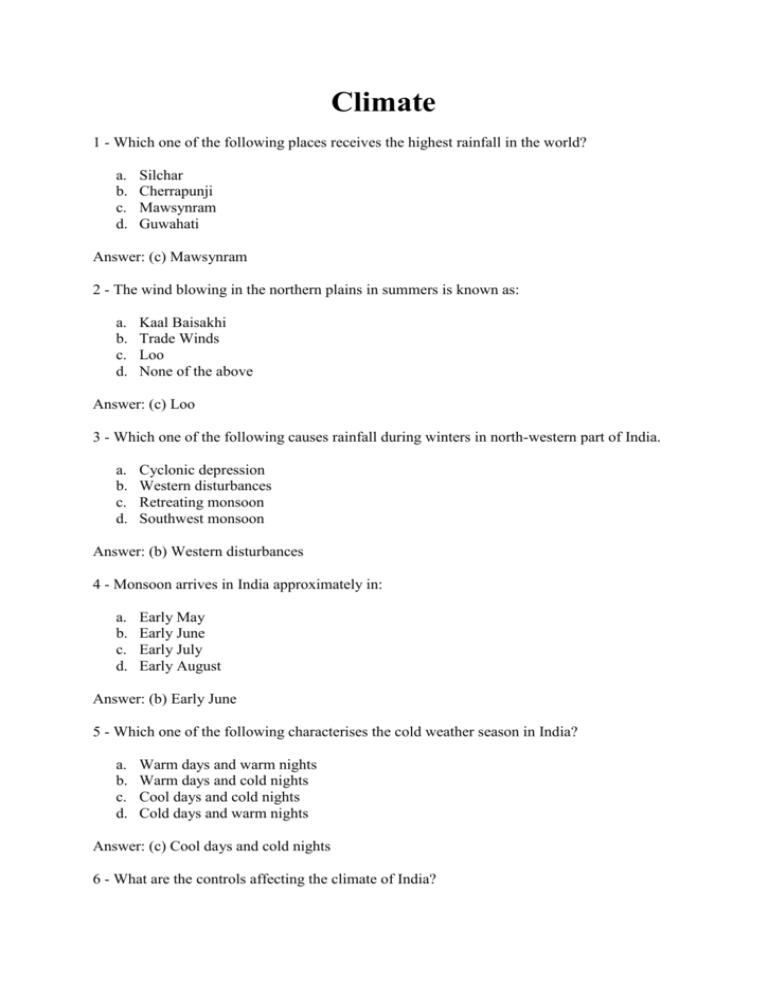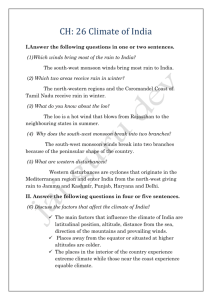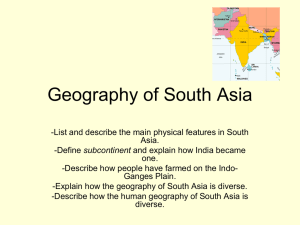gr9 Climate note - Answer key
advertisement

Climate 1 - Which one of the following places receives the highest rainfall in the world? a. b. c. d. Silchar Cherrapunji Mawsynram Guwahati Answer: (c) Mawsynram 2 - The wind blowing in the northern plains in summers is known as: a. b. c. d. Kaal Baisakhi Trade Winds Loo None of the above Answer: (c) Loo 3 - Which one of the following causes rainfall during winters in north-western part of India. a. b. c. d. Cyclonic depression Western disturbances Retreating monsoon Southwest monsoon Answer: (b) Western disturbances 4 - Monsoon arrives in India approximately in: a. b. c. d. Early May Early June Early July Early August Answer: (b) Early June 5 - Which one of the following characterises the cold weather season in India? a. b. c. d. Warm days and warm nights Warm days and cold nights Cool days and cold nights Cold days and warm nights Answer: (c) Cool days and cold nights 6 - What are the controls affecting the climate of India? Answer: Latitude, Altitude and Pressure and Winds are the main factors which affect the climate of India. 7 - Why does India have a monsoon type of climate? Answer: India comes in the Inter Tropical Convergence Zone (ITCZ). This fact; in association with various other factors, like the El Nino, Jet Stream and Coriolois Force are the reasons for monsoon type of climate in India. 8 - Which part of India does experience the highest diurnal range of temperature and why? Answer: Northwestern part of India experiences the highest diurnal range of temperature. This happens because of the presence of the Thar Desert and also because this region does not have the moderating influence of the ocean. 9 - Which winds account for rainfall along the Malabar coast? Answer: Monsoon winds 10 - What are Jet streams and how do they affect the climate of India? Answer: Fast flowing and narrow air currents are called jet streams. The streams flow at high altitudes (about 12,000 feet) in the troposphere. The westerly jet streams are responsible for western cyclonic disturbances in the north and north-western parts of India. The subtropical westerly jet stream moves north of the Himalayas with the apparent movement of the sun. The tropical jet stream (an easterly jet stream) blows over the Indian Peninsula; approximately over 14° north during the summer months. 11 - Define monsoons. What do you understand by “break” in monsoon? Answer: The seasonal reversal in wind direction during a year is called monsoon. Monsoon tends to have ‘breaks’ in rainfall; which means that there are wet and dry spells in between. The monsoon rains take place only for a few days at a time and then come the rainless intervals. 12 - Why is the monsoon considered a unifying bond? Answer: Although there are wide variations in weather patterns across India, the monsoon brings some unifying influences on India. The Indian landscape, its flora and fauna, etc. are highly influenced by the monsoon. The entire agricultural calendar in India is governed by the monsoon. Most of the festivals in India are related to agricultural cycle. These festivals may be known by different names in different parts of the country, but their celebration is decided by the monsoon. It is also said that the river valleys which carry the rainwater also unite as a single river valley unit. Due to these reasons, monsoon is often a great unifying factor in India. 13 - Why does the rainfall decrease from the east to the west in Northern India? Answer: The Bay of Bengal branch of the monsoon winds moves towards northeast and return westwards covering the northern plains. While they move towards west, their moisture contains tends to reduce with subsequent rains. Hence the rainfall decreases from east to west in northern India. 14 - Give reasons as to why. (a)Seasonal reversal of wind direction takes place over the Indian subcontinent? Answer: Seasonal reversal of wind direction over the Indian subcontinent takes place due to pressure differential. El Nino has major role to play in the seasonal reversal of wind direction over the Indian subcontinent. (b)The bulk of rainfall in India is concentrated over a few months. Answer: The monsoon begins from the first week of June and advances quite rapidly to cover almost the whole country by mid-July. Hence, the bulk of rainfall in India is concentrated over the months of a few months; mainly June to August. (c)The Tamil Nadu coast receives winter rainfall. Answer: The Tami Nadu coast receives winter rainfall because of movement of low-pressure conditions to the Bay of Bengal. (d)The delta region of the eastern coast is frequently struck by cyclones. Answer: The Bay of Bengal is the centre of various pressure changes and hence there is always a chance of development of cyclone. Due to this, the delta region of the eastern coast is frequently struck by cyclones. (e)Parts of Rajasthan, Gujarat and the leeward side of the Western Ghats are drought-prone. Answer: The parts fall in the rain shadow area of the Aravalli. Hence, they are drought prone. Question – 15 - Describe the regional variations in the climatic conditions of India with the help of suitable examples. Answer: Indian Peninsular shows wide variations in climatic conditions across various regions. For example; during winter season, the temperature goes into negative in the Himalayan region. In the northwestern India, temperatures can range between zero degree to 15°C during winter. During the same season, the temperature in Chennai remains a comfortable 25°C. The same variation can be seen in summer as well, while the temperature in Rajasthan can hover around 47°C, it is a comfortable 30°C in Chennai. 16 - Discuss the mechanism of monsoons. Answer: The low-pressure condition over the northern plains intensifies by the beginning of June. It attracts the trade winds from the southern hemisphere. These south-east trade winds cross the equator and blow in a south-westerly direction to enter the Indian peninsula as the south-west monsoon. These winds bring abundant moisture to the subcontinent. 17- Give an account of weather conditions and characteristics of the cold season. Answer: The temperature ranges between 10°-15°C in the northern plains. The weather is usually marked by clear sky, low temperatures and low humidity and feeble variable winds. The inflow of the cyclonic disturbances from the west and the northwest is a characteristic feature of the cold weather over the northern plains. These low-pressure systems originate over the Mediterranean Sea and Western Asia and move into India. They cause winter rains over the plains and snowfall in the mountains. 18 - Give the characteristics and effects of the monsoon rainfall in India. Answer: Monsoon tends to have ‘breaks’ in rainfall; which means that there are wet and dry spells in between. The monsoon is famous for its uncertainties. It may cause heavy floods in one part of the country, and may be responsible for droughts in other part. Because of its uncertain behaviour, it sometimes disturbs the farming schedule in India. This affects millions of farmers all over the country. 20. Write a brief note on the followings a.)Advancing and retreating monsoon in India. b.) Southern Oscillation and E1 Nino c) Monsoon as a unifying bond. Question No 20 refer textbook.








